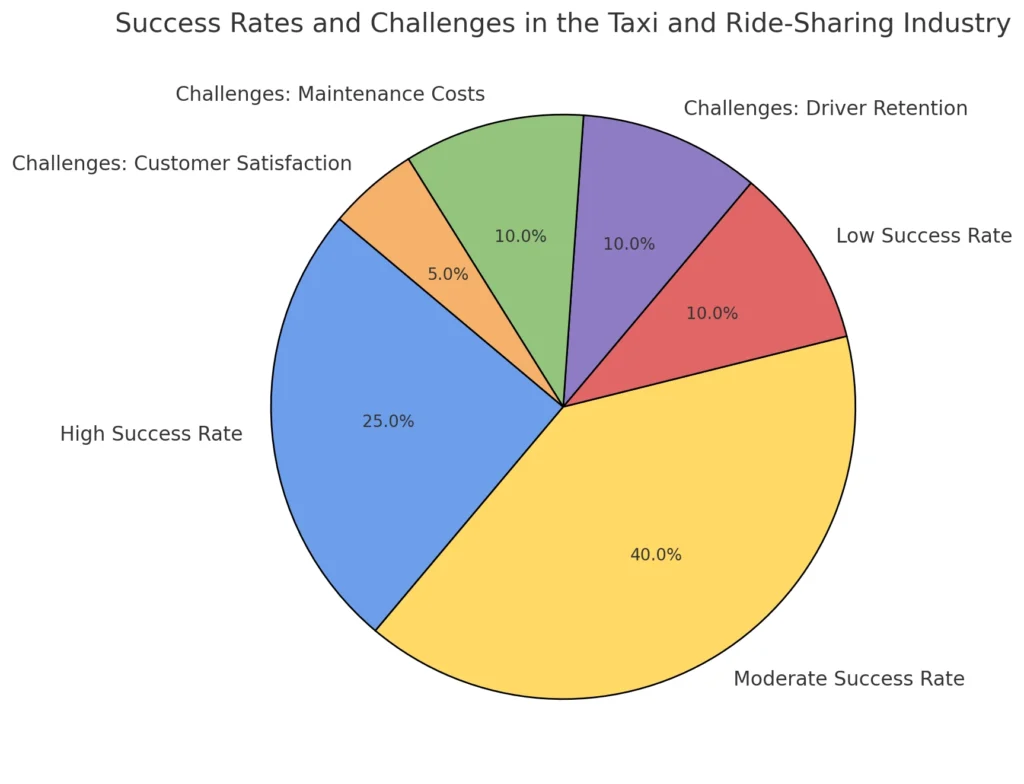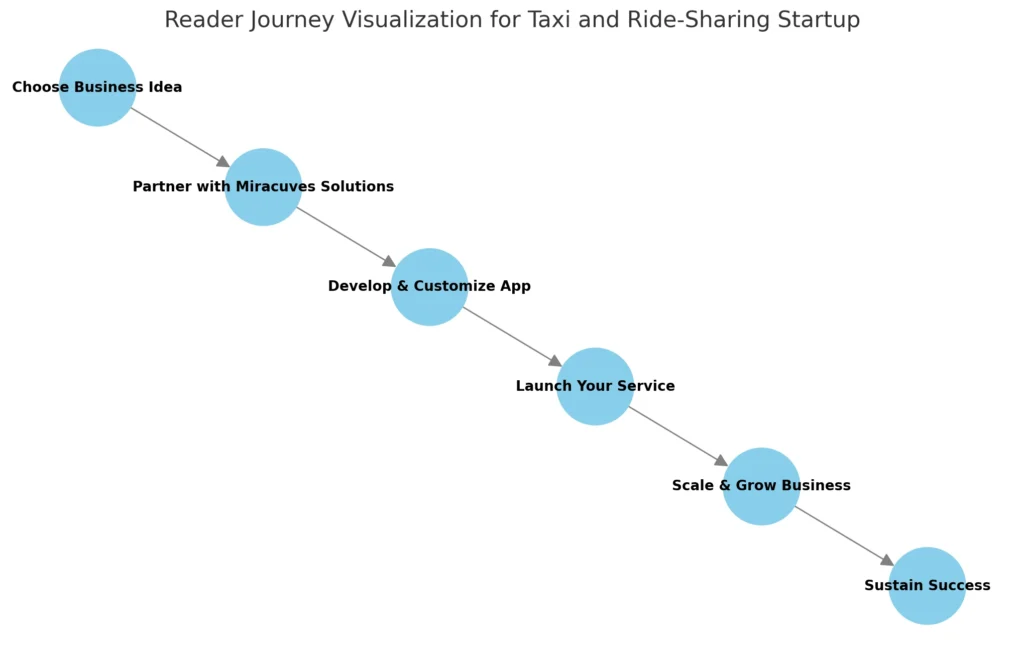In 2024, the taxi and ride-sharing industry continues to soar, driven by evolving urban lifestyles, technological advancements, and a growing demand for convenient, affordable transportation. Entrepreneurs worldwide are recognizing the potential in this dynamic market, where innovative ideas and unique services can carve out a profitable niche. With the global ride-sharing market projected to reach new heights, investing in this sector promises substantial growth and customer reach.
From eco-friendly ride solutions to personalized premium services, the opportunity to make a mark is vast. This guide explores the top 10 taxi and ride-sharing business startup ideas, offering insights into what’s trending, how to get started, and ways to tap into the ever-expanding customer base.
Why Choose the Taxi and Ride-Sharing Industry?

The taxi and ride-sharing industry is a powerhouse in today’s economy, blending innovation with convenience in a way that few other sectors can. As cities grow and people look for flexible, cost-effective travel options, demand for reliable, on-demand transport continues to surge. This industry isn’t just about getting passengers from point A to point B; it’s about addressing unique needs, whether it’s safe rides for children, eco-friendly options, or premium executive services. For budding entrepreneurs, this means an endless range of possibilities.
One of the biggest drivers of growth in this industry is technology. Real-time tracking, app-based booking, cashless payments, and AI-powered route optimization have transformed traditional taxi services into a seamless user experience. Meanwhile, trends like electric vehicles (EVs) and sustainable transportation solutions are shaping the future, making it a perfect time to enter the market with fresh ideas that cater to environmentally conscious customers.
Furthermore, projections show that the ride-sharing sector will only keep growing in the coming years. For an entrepreneur, this is not only a chance to enter a booming industry but also to be a part of shaping future urban mobility.
Current Trends and Future Opportunities in Taxi and Ride-Sharing
| Tendance/Technologie | Description | Impact sur l'industrie | Customer Appeal |
|---|---|---|---|
| Electric Vehicles (EVs) | Adoption of EVs for sustainable transport and reduced emissions. | Reduces carbon footprint and operational costs. | Appeals to eco-conscious customers. |
| Optimisation d'itinéraire basée sur l'IA | Uses AI to analyze traffic patterns and optimize routes for efficiency. | Shortens travel times and improves driver safety. | Enhances convenience and reliability. |
| Modèles d'abonnement | Fixed-cost monthly plans offering unlimited or bundled rides. | Increases customer loyalty and steady revenue. | Attracts frequent riders with predictable costs. |
| Automation & Autonomous Vehicles | Exploration of self-driving cars and automation in the ride-sharing space. | Potential for reduced driver dependency. | Future appeal for tech-savvy customers. |
| Expérience client personnalisée | AI analyzes rider preferences to offer tailored services and recommendations. | Boosts customer satisfaction and retention. | Appeals to users who value customization. |
The taxi and ride-sharing industry is evolving rapidly, driven by both technological advancements and changing customer expectations. One of the most significant trends today is the shift towards eco-friendly transport. As cities worldwide embrace green initiatives, electric vehicles (EVs) and hybrid cars are becoming the preferred options for ride-sharing companies, offering a sustainable solution to meet environmental standards and appeal to eco-conscious riders.
Automation and AI are also transforming the industry. Companies are experimenting with AI-powered algorithms to optimize routes, reduce wait times, and improve safety. In the near future, autonomous vehicles might take the industry to a whole new level, although current technologies are still focused on enhancing driver-assisted services. Meanwhile, AI-based customer insights are helping businesses understand rider preferences, enabling personalized and rewarding customer experiences.
Subscription-based services are another emerging trend, catering to users who prefer fixed-cost monthly ride plans over traditional pay-per-ride models. This model provides predictable pricing, which appeals to frequent riders and enhances customer loyalty. These developments highlight a major opportunity for new businesses: providing customized, flexible options that cater to specific user needs and preferences.
As more people embrace shared and sustainable mobility, the industry presents an exciting landscape for entrepreneurs. Whether it’s niche ride services, specialized transport solutions, or tech-driven efficiencies, there’s ample room for innovation and growth.
With the shift towards sustainable transport, véhicules électriques are becoming a preferred choice for ride-sharing, aligning with eco-conscious trends.
Top 10 Ideas for Taxi and Ride-Sharing Business Startups
Diving into the taxi and ride-sharing industry offers entrepreneurs a vast array of business models to explore. With increasing demand for niche and customized services, the following top 10 ideas stand out as profitable options in 2024:
| Idée d'entreprise | Coût de démarrage estimé | Marché cible | Rentabilité potentielle |
|---|---|---|---|
| Eco-Friendly Taxi Service | Moyen à élevé | Environmentally-conscious riders | High, due to demand for sustainable options |
| Luxury Ride Service | Haut | Business professionals, upscale clients | High, premium pricing attracts high-end clients |
| Women-Only Ride Service | Moyen | Female riders prioritizing safety | Moderate to High, niche market with loyal customers |
| Ride-Sharing for Seniors | Moyen | Elderly passengers | Moderate, meets essential needs with steady demand |
| Pet Taxi Service | Faible à moyen | Propriétaires d'animaux de compagnie | Moderate, unique offering with limited competition |
| School Transport Service | Moyen | Parents of school-age children | High, steady demand from parents seeking safety |
| Bike Taxi Service | Faible | Urban commuters | Moderate, lower fares but high trip volume |
| Healthcare Ride Service | Moyen à élevé | Patients needing non-emergency transport | High, consistent demand from healthcare facilities |
| Corporate Shuttle Service | Haut | Companies, business parks | High, lucrative corporate contracts possible |
| Subscription-Based Ride Service | Faible à moyen | Frequent riders seeking cost savings | High, builds customer loyalty and recurring revenue |
1. Eco-Friendly Taxi Service
A green taxi service using electric or hybrid vehicles, appealing to eco-conscious riders and supporting sustainable city initiatives.
- Focus: Environmentally-friendly transportation
- Marché cible : Eco-conscious riders, sustainable city initiatives
2. Luxury Ride Service
High-end vehicles with premium features provide comfort and style, targeting business professionals and upscale clients.
- Focus: Premium, high-comfort travel
- Marché cible : Professionals, upscale clientele
3. Women-Only Ride Service
A women-exclusive service with female drivers ensures a secure and comfortable option for female passengers.
- Focus: Safety and comfort for women
- Marché cible : Female riders prioritizing security
4. Ride-Sharing for Seniors
Specialized transport for elderly riders, offering assisted boarding and flexible stops to enhance accessibility and safety.
- Focus: Senior-friendly design and service
- Marché cible : Elderly individuals, accessible transport seekers
5. Pet Taxi Service
A dedicated pet transport service offering safe and comfortable rides for pets to vet visits, pet spas, and more.
- Focus: Pet-specific transportation
- Marché cible : Pet owners requiring transport solutions
6. School Transport Service
Safe and reliable rides for children to and from school, including features like GPS tracking and vetted drivers for parental peace of mind.
- Focus: Safe, reliable school transportation
- Marché cible : Parents, school-aged children
7. Bike Taxi Service
An eco-friendly and cost-effective bike taxi option for navigating urban areas and traffic congestion with ease.
- Focus: Urban, eco-friendly transport
- Marché cible : City dwellers, eco-conscious riders
8. Healthcare Ride Service
Non-emergency medical transport focused on patient comfort, including wheelchair accessibility and trained drivers.
- Focus: Patient-oriented medical transport
- Marché cible : Patients needing non-emergency transit
9. Corporate Shuttle Service
Group transportation for corporate clients, ideal for commuting to business parks and corporate hubs.
- Focus: Employee commute solutions
- Marché cible : Corporate clients, employee groups
10. Subscription-Based Ride Service
Monthly subscription ride bundles offer discounted rates, appealing to frequent riders looking for predictable and affordable options.
- Focus: Predictable, budget-friendly transport
- Marché cible : Frequent users, budget-conscious riders
Exemples du monde réel

The taxi and ride-sharing industry has seen impressive success stories, where businesses have thrived by tapping into specific market demands and staying adaptable. These examples highlight key insights for new entrepreneurs, showcasing how different business models can lead to success:
One popular example is of companies that pioneered the women-only ride service model. By addressing a core need for safety and comfort, they attracted a loyal customer base. Many of these services now operate across various cities, proving that niche, safety-focused ride options can flourish.
Another inspiring case is that of subscription-based ride services. These services saw rapid growth in urban centers where frequent riders looked for fixed-cost, unlimited travel options. By offering predictable pricing, they attracted daily commuters who prioritized cost efficiency, proving that a membership model can build long-term customer loyalty and steady revenue.
In smaller towns and rural areas, ride-sharing services for seniors have proven highly impactful. These companies cater to elderly customers who may require extra assistance and a level of comfort not often found in traditional taxis. This focus on accessibility and special needs has allowed them to establish a steady, loyal customer base and consistent demand.
These examples illustrate that focusing on a unique service or target group can carve out a profitable niche in the competitive ride-sharing industry. By aligning with customer needs and offering specialized services, startups can not only grow but build meaningful connections with their riders.
Mistakes to Avoid When Starting a Taxi or Ride-Sharing Business
| Erreur courante | Description | Mesure préventive |
|---|---|---|
| Ignorer les commentaires des clients | Not addressing customer needs or preferences, leading to dissatisfaction. | Regularly collect and act on customer feedback to improve service quality. |
| Overlooking Driver Satisfaction | High driver turnover due to lack of incentives or fair compensation. | Offer competitive pay, incentives, and flexible scheduling to retain drivers. |
| Sous-estimation des coûts opérationnels | Miscalculating expenses such as maintenance, fuel, and insurance, impacting cash flow. | Budget realistically for ongoing costs, and plan for regular vehicle maintenance. |
| Manque d'identité de marque claire | Failure to stand out in a competitive market, leading to weak customer recognition. | Develop a unique brand based on target market needs (e.g., luxury, affordability). |
| Neglecting Vehicle Maintenance | Delayed maintenance results in costly repairs and potential safety risks. | Schedule regular maintenance to ensure safety and reduce long-term repair costs. |
Launching a successful taxi or ride-sharing business comes with its share of challenges. Entrepreneurs often learn through trial and error, but understanding common pitfalls beforehand can save time, resources, and effort. Here are some mistakes to watch out for:
One frequent misstep is ignoring customer feedback. Riders often have specific needs and expectations, and listening to them can be a game-changer. From adjusting vehicle comfort levels to refining app features, customer input should guide continuous improvements.
Another common challenge is overlooking driver satisfaction. Drivers are the backbone of any ride-sharing service, and their retention is crucial. Providing fair compensation, flexible work schedules, and incentives can significantly improve driver morale and reduce turnover, which translates to consistent service for customers.
Sous-estimer les coûts opérationnels is another pitfall. Vehicle maintenance, insurance, fuel, and technology upgrades are ongoing expenses. It’s vital to budget these costs realistically from the start to avoid cash flow issues later. Regular vehicle maintenance not only improves safety but also reduces long-term repair costs, which benefits both the business and customer experience.
Enfin, failure to establish a clear brand identity is a missed opportunity. In a competitive market, standing out is essential. A well-defined brand—whether it’s based on luxury, affordability, or niche services—attracts and retains the right audience.
Avoiding these common mistakes paves the way for a smoother, more successful journey in the ride-sharing business. With a focus on customer feedback, driver retention, cost management, and strong branding, startups can set themselves up for long-term growth.
Listening to customer feedback can be a game-changer in improving service quality and building loyalty.
Pourquoi faire confiance aux solutions Miracuves pour votre prochain projet ?

When it comes to launching a taxi or ride-sharing business, choosing the right development partner can be the difference between success and struggle. Miracuves Solutions stands out as a trusted choice, delivering high-quality, ready-made app solutions at an affordable rate and in a fraction of the usual development time. With a deep understanding of the taxi and ride-sharing industry’s unique needs, Miracuves Solutions brings years of expertise in crafting custom apps tailored to the exact specifications of each client.
Miracuves Solutions focuses on ensuring that each app is scalable, user-friendly, and equipped with cutting-edge features such as real-time tracking, seamless payment systems, and route optimization. Our approach is client-centered, which means we don’t just deliver a product—we deliver a fully operational solution designed to grow with your business and meet the demands of today’s market. Our history of successful projects speaks volumes, with numerous clients launching and scaling their businesses efficiently.
For those seeking a cost-effective, reliable, and expertly crafted solution, Les solutions Miracuves provides not just the technology but a pathway to long-term growth and success in the taxi and ride-sharing industry.
Conclusion
Starting a taxi or ride-sharing business in 2024 offers exciting opportunities for innovation, growth, and community impact. With a range of unique business models available, entrepreneurs can find their niche—whether it’s eco-friendly taxis, senior transport services, or premium ride options. The industry’s upward trend, coupled with advancements in technology and shifting customer preferences, creates a thriving environment for new players to enter the market.
Success in this field comes from choosing the right idea, staying attuned to customer needs, and adapting to trends. With the right approach and a strong support system, entrepreneurs can turn a ride-sharing startup into a lasting, profitable business that benefits communities and meets today’s dynamic mobility demands.
FAQ
What are the initial steps to start a taxi or ride-sharing business?
Begin with market research, define your business model, acquire necessary licenses, and develop a user-friendly app for bookings.
How much investment is needed for a ride-sharing startup?
Investment varies by model but generally covers vehicle costs, technology development, and marketing. Budgeting carefully can make the process manageable.
What features should a ride-sharing app include?
Essential features include real-time tracking, payment integration, driver and customer profiles, and a rating system to ensure quality.
How can I differentiate my business from existing competitors?
Focus on niche markets, such as eco-friendly or senior-focused services, and build strong branding to attract targeted customers.
Is a taxi or ride-sharing business profitable?
With the right business model and management, a ride-sharing business can be highly profitable, especially in urban areas with high demand.





























































